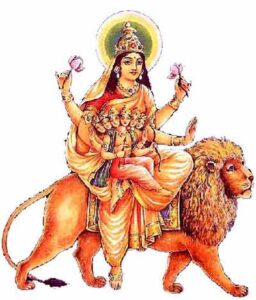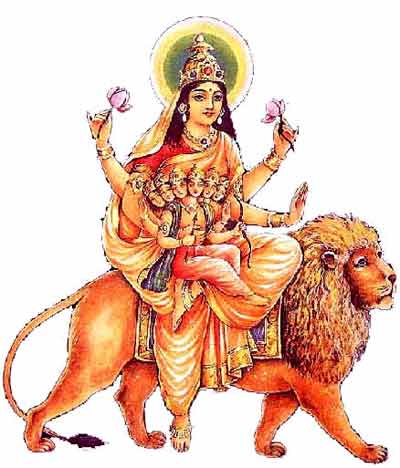
The fifth day of Navarathri is given over to Goddess Skandamata. Skanda is one of the names of Subramanya or Lord Muruga or Kartik – the General of the Army of the Devas and the most handsome God. Skanda Mata is the mother of Kartik. She is also known as Padmasana. The colour of the day is Royal Blue.
Bhagavad Gita 10:34 … Of the qualities that, due to their grace and tenderness, are termed ‘female’, I am fame and fortune, sweet speech, memory, intelligence, steadfast perseverance, loyalty, and forgiveness.
To make up the nine nights, we will add repositories of truth and culture to the list given from the Bhagavad Gita.
Goddess of Day 5: Skandamata
Day five is dedicated to goddess Skandamata. Lord Kartikeya is known as Lord Skanda and hence goddess Parvati is also known as Skandamata. Day 5 of the Navratri festival is dedicated to Skandamata – mother of Lord Skanda.
Carrying a baby Murugan or Lord Kartikeya, brother of Lord Ganesha, Skandamata mounts on a ferocious lion. The goddess is generally depicted with four hands – carrying lotus in two hands, she is holding baby Murugan in one hand and keeps the other hand in ‘abhaya mudra’. This the motherly form of Durga and she is benevolent.
Stuti:
Ya Devi Sarvabhuteshu Maa Skandamata Rupena Samsthita
Namastasyai Namastasyai Namastasyai Namo Namaha
Women and Selflessness, Sacrifice:
There are several organisations which are being run by women with great dedication and zeal for the benefit of the people. Valmiki extolled the sweetness of womanhood. What is the cause of this sweetness? The spirit of sacrifice is the cause, according to Valmiki.
A mother is ready to sacrifice everything even her life, for the sake of her child. Such a spirit is to be found only among women. If a child is grievously ill, the father may say that the child may as well die. But the mother will try to save the child at any cost. It is for this reason, that woman is described as thyagamuurthi, the embodiment of sacrifice. Men do not have the same spirit of sacrifice as women. Men may present a heroic pose, but do not have the determination and perseverance to carry on the struggle to the end. Valmiki described woman as the embodiment of devotion. Man was described as embodiment of wisdom. The wisdom (jnani) has limited access to the Divine mansion. But the woman devotee has access to innermost apartments. The pre-eminent status accorded to women is evident from all the ancient scriptures.

Space was born from you in the time before time
and time itself, and death.
The Dying One was born
leaping fully armed from your womb
rising up to order the world.
The wasters poured out, to be placed in their proper
locations,
and sold ground was born, to support their weight,
to be the cup of their encircling border.
The directions were placed, each where it belonged.
And life itself was born, the unpredictable,
your youngest children, we were born,
not always knowing where we belong.
And now I wish to praise the Mother,
who made these things to be,
the source of existence, the granter of life.
You to whom we all belong,
you who knows the way we should go,
I praise you with my words,
I hold you in my heart.
108 Names of the Divine Mother (English)
Om… I bow to SHE who is the Mother of the Universe.
Each of the Divine Names (in English) ends with ~ swaha.
When you use the Sanskrit word swaha you are invoking the God / Goddess, you are arousing the God / Goddess to come and witness your action, to come and receive your prayer.
We append these 108 Names of the Divine Mother and pray that you will be understanding the significance of the prayers, along with the efficacy of same.
Download the 108 Names of the Divine Mother

It is said that each day has a colour, and that idols of the Gods worshipped on these days are clothed in sari and other clothing in the colours given. Several sources give several colours. We will be following the day colours as given by Drik Panchang, which may vary from other sources. It is not our intention to cause offence with colours given.
![]()

